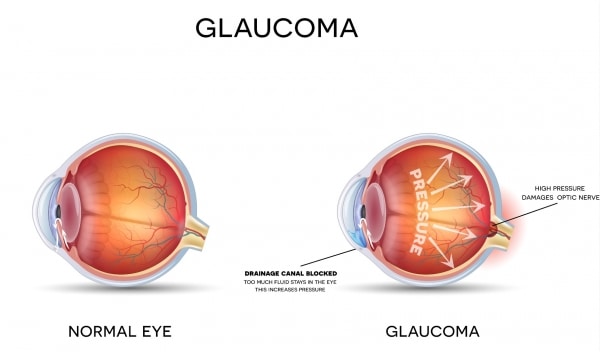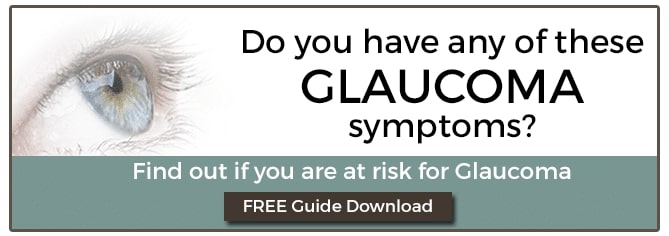Serving Loveland, Fort Collins, Greeley, Longmont & Areas Nearby in Colorado
Glaucoma is a condition caused by an increase in intraocular pressure, which ultimately damages the optic nerve. When left untreated, this eye disease will cause blind spots in your visual field and eventually lead to a complete loss of vision. It is one of the leading causes of blindness in the United States, with more than 200,000 new cases diagnosed every year.
Glaucoma is an age-related vision disorder, occurring most often in people over the age of 40. This makes yearly visits for vision exams incredibly important as you age. Glaucoma is often asymptomatic to start and vision loss may be slow to progress. Once vision is lost, however, it cannot be restored. Glaucoma can be controlled, but it is not curable.

What Are The Symptoms of Glaucoma?
For many types of glaucoma, there is neither pain nor detectable symptoms until you start losing your vision. For this reason, your condition may go undetected until you've already sustained irreversible damage to your optic nerve.
Depending on the type of glaucoma you are experiencing, symptoms of the disease may include:
- The development of blind spots in your peripheral vision
- Decreased or blurred vision
- Seeing halos and rainbows
- Redness in the eye
Some types of glaucoma may also come with severe pain or pressure in the eye, headache, nausea, and vomiting.

Early detection and treatment of this eye disease can help you slow the progression of glaucoma and prevent further vision loss. If it has been longer than a year since your last eye exam, please call (970) 669 - 1107 today to schedule an appointment at our Loveland ophthalmology practice. We welcome patients from all surrounding communities including Windsor, Severance, Berthoud, Fort Collins, and Wellington.
Are There Different Types of Glaucoma?
There are two primary types of glaucoma:
- Open-Angle Glaucoma. Open-angle glaucoma occurs when blockage in the eye’s drainage system allows for fluid buildup, eventually damaging the optic nerve. This type of glaucoma occurs in both eyes and does not produce any symptoms while developing, which makes frequent visits to the eye doctor all the more important as you age. Open-angle glaucoma accounts for more than 90% of all glaucoma diagnoses
- Closed-Angle Glaucoma. This uncommon form of glaucoma is caused by an irregular position of the iris. When the iris shifts in position, it blocks the eye's drainage system. Closed-angle glaucoma typically develops in one eye at a time and may occur suddenly, resulting in rapid vision loss
Other Types of Glaucoma
In addition to the two primary types of glaucoma, the ophthalmologists at Kirk Eye Center can diagnose and provide treatment for less common forms of the conditions including:
- Irido Corneal Endothelial Syndrome (ICE)
- Neovascular Glaucoma
- Normal-Tension Glaucoma (NTG)
- Pigmentary Glaucoma
- Pseudoexfoliative Glaucoma
- Secondary Glaucoma
- Traumatic Glaucoma
- Uveitic Glaucoma
Congenital glaucoma, an inherited form of the disease, occurs when the eye’s drainage canals do not properly form during the prenatal period. Congenital glaucoma may be treated with medication, surgical intervention, or microsurgery. Like all other types of glaucoma, it cannot be cured, but it can be managed, allowing children born with this vision disorder to retain their sight for a lifetime with proper care.

Glaucoma Causes
Glaucoma is caused by inflation of pressure in the eye, causing damage to the optic nerve. Everyone is at risk for glaucoma, but the condition tends to develop most often in men and women over the age of 60. For people of African descent, the condition may begin to develop earlier.
You may be at a higher risk for glaucoma if you have a family history of the disease. It is also more common in people with high myopia (nearsightedness).
People of Hispanic, Asian, and African descent are more likely to develop glaucoma. So too are people who have suffered an eye injury or trauma. Hypertension (high blood pressure), cardiovascular disease, and diabetes are also known risk factors for glaucoma.
Lifestyle Choices
For many, there is little that can be done to reduce the risks of developing glaucoma. However, there are certain lifestyle choices that can increase your risks for glaucoma, the seconds leading cause of blindness in the United States. These include:
- Tobacco use
- Excessive alcohol use
- Excessive caffeine intake
- Obesity
- Steroid use
- Overexposure to UVA/UVB rays
You may be able to reduce your risks for glaucoma by simply leading a healthier life. During your time in our care, we can provide you with additional information on the most effective ways to reduce your risks for this vision-stealing condition.
Diagnosing & Treating Glaucoma
Because glaucoma cannot be cured, early detection and prompt treatment remain the best ways to prevent future vision loss. We strongly encourage you to undergo regular glaucoma screenings as part of your yearly vision exams after the age of 40. These may include:
- Tonometry: Measurement of intraocular pressure
- Gonioscopy: An examination of the drainage system to detect abnormalities that can cause glaucoma
- Ophthalmoscopy: Microscopic examination of your optic nerve to identify signs of damage
- Visual field testing: A computerized visual field analyzer that determines whether your eye can detect small and dim lights in your peripheral vision
Glaucoma can be diagnosed through these methods, even when it is currently asymptomatic. As soon as the condition is diagnosed, appropriate treatment can begin.
Glaucoma is a blinding disease, but it is very treatable, often with the use of prescription eye drops. The goal of treatment is to lower the intraocular pressure. With careful monitoring and treatment, we can often prevent noticeable vision loss.
Depending on the type and severity of your glaucoma, Dr. Kirk may recommend one of the following treatments:
- Eye drops to lower intraocular pressure
- Laser treatment to increase the drainage of fluid from your eye
- Glaucoma surgery to create new drainage pathways in your eye
Glaucoma treatment is a major focus of Dr. Kirk's practice and he takes pride in providing exceptional glaucoma care. With extensive experience diagnosing and treating the condition, Dr. Kirk offers a variety of safe and effective treatment options, enabling him to meet the specific needs of each patient.
How Common Is Glaucoma?
About 3 million people in the U.S. have glaucoma, according to the Centers for Disease Control and Prevention. Most of those affected are age 40 or older. It is one of the leading causes of blindness globally. According to the National Eye Institute, about 1.9 percent of the U.S. population over age 40 had glaucoma in 2010, and the percentage has likely increased since then.
Glaucoma is not uncommon. You certainly shouldn’t feel unsupported or alone if you are wondering about glaucoma symptoms or treatment. Our experienced team is here to help you find answers.
How Can I Prepare For Glaucoma Treatment?
Preparing for glaucoma treatment depends entirely on which treatment you choose. Below, we outline some of the general ways you can prepare for laser-based and other types of glaucoma surgery:
- Wear loose, comfortable clothing. If you need to put on and later remove a surgical gown, you’ll want to have something like a button-up blouse that you don’t have to pull over your head after eye surgery. You will of course be able to put a shirt on over your head, but avoiding the issue will ensure your comfort and prevent bumping the surgical area.
- Don’t use contact lenses the day of surgery. Wearing glasses is required the day of your surgery, if you wear prescription lenses.
- Skip the makeup, jewelry, and facial creams. Your face should be bare and clean the day of surgery.
- Follow our directions for eating and drinking before surgery. You may need to stop eating and drinking a certain number of hours before surgery, depending on which type of anesthesia will be administered.
- Follow our instructions for medications and supplements. You may need to temporarily discontinue use of certain medications and herbal supplements, but only do so if instructed by our eye doctors.
- Arrange for someone to drive you home. A family member, your spouse, or a friend will need to drive you home from surgery. You’ll also need help around the house or if you need any errands completed that day.
Cataract surgery is an outpatient procedure and does not require an overnight stay in a hospital. We’ll make sure you have complete preoperative and post-operative instructions.
Glaucoma is not uncommon. You certainly shouldn’t feel unsupported or alone if you are wondering about glaucoma symptoms or treatment. Our experienced team is here to help you find answers.
What Happens If Glaucoma Goes Untreated?
Untreated glaucoma causes progressive vision loss. If it’s never treated, glaucoma will eventually lead to blindness.
For most people, glaucoma progresses slowly and gradually over several years, eventually damaging the optic nerve to the point of permanent blindness. Before that stage is reached, a person with glaucoma may first experience blind spots in their peripheral vision, and then tunnel vision, before total vision loss.
Early detection of glaucoma is one of the reasons that routine eye exams are so important, as well as scheduling exams if you have any change in your vision. Treatment slows the progression of the disease and aims to protect your quality of life!
What Is Recovery Like From Glaucoma Treatment?
The duration of the recovery depends on the exact surgery. We will provide you with detailed aftercare instructions, which generally include:
- Take 1-2 weeks off from work
- Limit how much you lift and bend for a few weeks
- Don’t drive until your vision has returned to normal
- Avoid strenuous exercise for a few weeks
- Don’t wear eye makeup for a few weeks
- Avoid swimming and hot tubs for a few weeks
- Don’t wear contact lenses
- Don’t rub your eyes (we can provide an eye shield or you can use protective glasses to prevent hitting or bumping your eyes)
Your vision will probably be blurry for a few weeks before it resolves. A smaller number of people experience blurriness for a few months. It will probably feel like you have something stuck in the eye that was operated on - a sensation of grittiness. This too will resolve soon. It’s important not to rub the eye even though you may want to. Your eyes will probably look red and irritated, and we will make sure you know how to differentiate between these normal healing side effects and signs of a problem.
The exact timeline will vary. Recovery from laser surgery is usually faster, and may be resolved by 2-3 weeks after surgery. Your recovery will also depend on the vision in the eye that was not operated on, and the severity of glaucoma that was in the other eye. Recovery will also depend on your job, lifestyle, hobbies, exercise routine, and other factors. Rely on us to provide instructions customized to your life.
Is Glaucoma Treatment Painful?
The surgeries themselves will not be painful. After surgery, you may experience soreness, irritation, the sensation of something in your eye, and mild discomfort for several weeks. Any significant pain should be reported to the eye doctor so they can determine the right way to relieve it. Most people do not have to take prescription pain meds for very long or at all after glaucoma surgery. Pain-relieving eye drops are commonly used.
Will I Need More Treatment In The Future?
Certain people end up needing another glaucoma surgery in the years after their initial procedure. In some cases, laser surgery is ultimately not sufficient and a different surgical method must be used. Or, scarring of the new drainage channel may require re-treatment. When you visit our eye doctors for your ongoing care and checkups, they will be able to monitor your eye pressure and recommend treatments as needed.
Why Choose Kirk Eye Center for Glaucoma Treatment

Kirk Eye Center has been offering comprehensive ophthalmology and optometry services for over 33 years, making it a trusted choice for locals seeking glaucoma treatment. Dr. John D. Kirk, MD FACS, a board-certified ophthalmologist, brings his extensive training and expertise to every surgical procedure, ensuring patients receive top-quality care. As an early adopter of the latest treatments, Dr. Kirk stays ahead in providing cutting-edge solutions for glaucoma and other serious eye conditions. The center’s talented staff is dedicated to offering personalized treatments, making every patient feel like a valued family member.
The fully licensed and accredited outpatient surgery center at Kirk Eye Center is equipped with the most advanced technology, ensuring patients have access to exceptional care in a safe environment. Dr. Kirk, who is local to the area, takes pride in serving his community with a commitment to excellence. Patients can expect individualized attention from a team that genuinely cares about their well-being, making Kirk Eye Center the ideal destination for those seeking expert glaucoma treatment.
Frequently Asked Questions
How often should I have an eye exam to check for glaucoma?
You should have a comprehensive eye exam every one to two years, especially if you are over the age of 40, have a family history of glaucoma, or belong to a high-risk group. If you are at higher risk, your eye doctor may suggest more frequent checkups to monitor for changes.
Can glaucoma be cured?
Currently, there is no cure for glaucoma, but you can manage your condition with treatment. Early detection and ongoing treatment can help control disease progression and prevent further vision loss.
Is it possible to have glaucoma without symptoms?
Yes, it is possible to have glaucoma without obvious symptoms, especially in the early stages. Regular eye exams are crucial, as glaucoma can cause gradual vision loss without warning signs until it has reached an advanced stage.
Can glaucoma return after surgery or treatment?
While treatment can effectively lower eye pressure and manage glaucoma, it is possible for the condition to progress or for eye pressure to increase again over time. Continue with regular checkups so your eye doctor can monitor your condition and adjust treatment if needed.
How long do glaucoma treatments take to work?
The effectiveness of glaucoma treatments varies depending on the individual and the treatment method used. Eye drops may start working within a few hours to days, while laser treatments or surgery may take a few weeks to show their full effect. Dr. Kirk will monitor your eye pressure regularly to ensure the treatment works effectively.
At what age should I start getting checked for glaucoma?
You should start having glaucoma screenings at age 40, as this is when the risk begins to increase. However, if you have a family history of glaucoma or other risk factors, you should start screenings earlier, as recommended by your eye doctor.
How do I support a loved one with glaucoma?
You can assist loved ones by reminding them to take their medications, accompanying them to appointments, and learning more about glaucoma to better understand what they’re experiencing. Providing emotional support and helping adapt their living environment to be more vision-friendly can also be incredibly beneficial.
Contact Kirk Eye Center for a Vision Screening
If it has been longer than 12 months since your last vision screening or if you are experiencing vision difficulties or loss, please call Kirk Eye Center at (970) 669 - 1107 to schedule a glaucoma screening today. We serve patients in Loveland, Fort Collins, Windsor, and communities throughout Northern Colorado.



